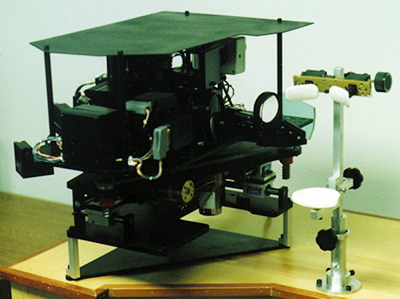The Eyes Have It
Serious buffeting that may occur when flying at high speed and low altitude can create visual blurring, hindering a pilot's ability to fly safely. NASA-funded research into the muscular physiology of eye vibration was the impetus for an optical instrument, now in medical use, that accurately measures eye movements.
Starting as far back as 1965, NASA's Ames Research Center contracted with the Stanford Research Institute (SRI) International of Menlo Park, California, to model the human visual-accommodation system, starting directly with the retinal image. This research was directed at how the major muscle systems control the human visual system.
Although a considerable amount of experimental information had been gathered regarding each of these systems, there was scant understanding of how control was actually achieved. One question that had gone unanswered was the voluntary and involuntary aspects of the human eye
Several years of incremental NASA funding helped foster SRI-built eyetracking devices. These tools were able to anticipate, track, and monitor involuntary ocular movement horizontally, vertically, and with respect to depth of field. This development did not go unnoticed by leading academic and research institutions as an important instrument for understanding the visual system.
Since 1988, Fourward Optical Technologies, Inc., of San Marcos, Texas, has been manufacturing and marketing the Dual-Purkinje-Image (DPI) Eyetracker under an exclusive license. Purkinje images are four reflections produced from the front and rear surfaces of the cornea and lens. By observing the movement of the first and fourth Purkinje images with the DPI Eyetracker, the direction of gaze over a large, two-dimensional visual field can be determined with great accuracy. The instrument operates with infrared light, requires no attachments to the eye, and is not disruptive to normal vision.
Since its introduction by SRI, the Eyetracker has gone through several generations of development. The price of the early device was cut by more than half, making it suitable for clinical medical use. Applications of the Eyetracker are impressive. In cases of ocular bleeding, lasers can be used to stem the flow. The Eyetracker makes it possible to accurately target these problem areas, increasing the accuracy and the effectiveness of the treatment. Also, various brain disorders can now be diagnosed, as the Eyetracker can zero-out the eye's involuntary movements during diagnosis. Working in concert with lasers, the Eyetracker can assist non-invasive determination of a patient's circulatory health. By accounting for the eye's natural involuntary movements, the Eyetracker enables the operator to monitor blood flow by accurately targeting the retinal capillaries for Doppler blood flow studies.
The Eyetracker has a pointing accuracy on the order of one minute of arc and a response time on the order of one millisecond. By attaching Fourward Optical Technologies' Infrared Optometer to the device, continuous measurement of eye focus is possible, producing a 3-D Eyetracker. Eyetracker units are installed in over 11 countries around the globe, in addition to 30 or more sites in the United States.
Current and potential applications of the Fourward Optical Technologies' DPI Eyetracker include analysis of visual perception, mapping retinal features, neurological investigation, drug evaluation, and even the analysis of advertising material. No doubt the company has an eye toward the future.

The Eyetracker, built by Fourward Optical Technologies, can precisely monitor eye movements, benefiting the medical field in various ways, from neurological diagnosis to blood flow monitoring.













